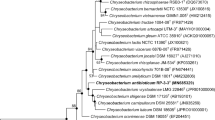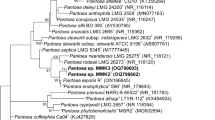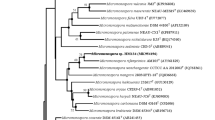Abstract
A novel plant growth-promoting and indole acetic acid (IAA) producing strain designated RG1T was isolated from the roots of Tagetes patula (marigold) collected from Goyang, South Korea. The cells of strain RG1T is aerobic, yellow, Gram-stain-negative, pleomorphic and non-motile. Phylogenetic analysis based on 16S rRNA gene sequences revealed that strain RG1T belongs to the genus Chryseobacterium and is closely related to Chryseobacterium gwangjuense THG-A18T (98.6%). The strain produced IAA (70.5 µg ml−1) in the presence of L-tryptophan and showed antimicrobial activity against Gram-negative bacterium Xanthomonas campestris pv. campestris KACC 10377T. The isolate had a significant positive effect on rice plant shoot and root growth. The novel strain RG1T had a draft genome size of 4,430,189 bp, with ten scaffolds and 3969 protein-coding genes. The digital DNA-DNA hybridization (dDDH) and average nucleotide identity (ANI) values between strain RG1T and other closely related members ranged from 21.5 to 36.6% and from 79.2 to 86.6%, respectively. The genomic DNA G + C content was 34.8 mol%. Furthermore, anti-SMASH analysis of the whole genome revealed six putative biosynthetic gene clusters responsible for various secondary metabolites. The major respiratory quinone was MK-6 and the major fatty acids were iso-C15:0, summed feature 3 (comprising C16: 1ω7c and/or C16: 1ω6c) and summed feature 9 (comprising iso-C17: 1 ω9c and/or 10-methyl C16:0). The major polar lipid is phosphatidylethanolamine. Based on the genotypic, chemotaxonomic and physiological data, strain RG1T represents a novel species, for which the name Chryseobacterium tagetis sp. nov. is proposed. The type strain is designated as RG1T ( = KCTC 82696T = NBRC 115057T).
This is a preview of subscription content, access via your institution
Access options
Subscribe to this journal
Receive 12 print issues and online access
$259.00 per year
only $21.58 per issue
Buy this article
- Purchase on Springer Link
- Instant access to full article PDF
Prices may be subject to local taxes which are calculated during checkout



Similar content being viewed by others
References
Vandamme P, Bernardet JF, Segers P, Kersters K, Holmes B. New perspectives in the classification of the Flavobacteria: description of Chryseobacterium gen. nov., Bergeyella gen. nov., and Empedobacter nom. rev. Int J Syst Bacteriol. 1994;44:827–31.
Bernardet JF, Segers P, Vancanneyt M, Berthe F, Kersters K, et al. Cutting a gordian knot: emended classification and description of the genus Flavobacterium, emended description of the family Flavobacteriaceae, and proposal of Flavobacterium hydatis nom. nov. (Basonym, Cytophaga aquatilis Strohl and Tait 1978). Int J Syst Bacteriol. 1996;46:128–48.
Weon HY, Kim BY, Yoo SH, Kwon SW, Stackebrandt E, Go SJ. Chryseobacterium soli sp. nov. and Chryseobacterium jejuense sp. nov., isolated from soil samples from Jeju, Korea. Int J Syst Evol Microbiol. 2008;58:470–3.
Kim T, Kim M, Kang O, Jiang F, Chang XL, et al. Chryseobacterium frigidum sp nov., isolated from high-Arctic tundra soil, and emended descriptions of Chryseobacterium bernardetii and Chryseobacterium taklimakanense. Int J Syst Evol Microbiol. 2016;66:609–15.
Pires C, Carvalho MF, De Marco P, Magan N, Castro PML. Chryseobacterium palustre sp. nov. and Chryseobacterium humi sp. nov., isolated from industrially contaminated sediments. Int J Syst Evol Microbiol. 2010;60:402–7.
Loch TP, Faisal M. Chryseobacterium aahli sp. nov., isolated from lake trout (Salvelinus namaycush) and brown trout (Salmo trutta), and emended descriptions of Chryseobacterium ginsenosidimutans and Chryseobacterium gregarium. Int J Syst Evol Microbiol. 2014;64:1573–9.
Wu YF, Wu QL, Liu SJ. Chryseobacterium taihuense sp. nov., isolated from a eutrophic lake, and emended descriptions of the genus Chryseobacterium, Chryseobacterium taiwanense, Chryseobacterium jejuense and Chryseobacterium indoltheticum. Int J Syst Evol Microbiol. 2013;63:913–9.
Chaudhary DK, Kim J. Chryseobacterium nepalense sp. nov., isolated from oil-contaminated soil. Int J Syst Evol Microbiol. 2017;67:646–52.
Chen FL, Wang GC, Teng SO, Ou TY, Yu FL, et al. Clinical and epidemiological features of Chryseobacterium indologenes infections: analysis of 215 cases. J Microbiol Immunol. 2013;46:425–32.
Kämpfer P, Fallschissel K, Avendaño-Herrera R. Chryseobacterium chaponense sp. nov., isolated from farmed Atlantic salmon (Salmo salar). Int J Syst Evol Microbiol. 2011;61:497–501.
Reynaud I, Chanteperdrix V, Broux C, Pavese P, Croizé J, et al. [A severe form of Chryseobacterium indologenes pneumonia in an immunocompetent patient]. Med Mal Infect. 2007;37:762–4.
Smith J, Han R, Mailman T, MacDonald N. Chryseobacterium indologenes: distinguishing pathogen from contaminant in a neonate. J Ped Infect Dis. 2012;7:31–5.
Lucas JA, Ramos Solano B, Montes F, Ojeda J, Megias M, et al. Use of two PGPR strains in the integrated management of blast disease in rice (Oryza sativa) in Southern Spain. Field Crops Res. 2009;114:404–10.
Kim HS, Sang MK, Jeun Y-C, Hwang BK, Kim KD. Sequential selection and efficacy of antagonistic rhizobacteria for controlling Phytophthora blight of pepper. Crop Prot. 2008;27:436–43.
Montero-Calasanz MC, Göker M, Rohde M, Spröer C, Schumann P, et al. Chryseobacterium hispalense sp. nov., a plant-growth-promoting bacterium isolated from a rainwater pond in an olive plant nursery, and emended descriptions of Chryseobacterium defluvii, Chryseobacterium indologenes, Chryseobacterium wanjuense and Chryseobacterium gregarium. Int J Syst Evol Microbiol. 2013;63:4386–95.
Dahal RH, Chaudhary DK, Kim D, Pandey RP, Kim J. Chryseobacterium antibioticum sp. nov. with antimicrobial activity against Gram-negative bacteria, isolated from Arctic soil. J Antibiot. 2021;74:115–23.
Chhetri G, Kim J, Kim I, Kang M, Seo T. Chryseobacterium caseinilyticum sp. nov., a casein hydrolyzing bacterium isolated from rice plant and emended description of Chryseobacterium piscicola. Int J Syst Evol Microbiol. 2021;71:004854.
Ambu G, Chaudhary RP, Mariotti M, Cornara L. Traditional uses of medicinal plants by ethnic people in the Kavrepalanchok District. Cent Nepal Plants 2020;9:759.
Sandhya V, Ali SKZ, Grover M, Reddy G, Venkateswarlu B. Alleviation of drought stress effects in sunflower seedlings by the exopolysaccharides producing Pseudomonas putida strain GAP-P45. Biol Fertil Soils 2009;46:17–26.
Ullah A, Heng S, Munis MFH, Fahad S, Yang X. Phytoremediation of heavy metals assisted by plant growth promoting (PGP) bacteria: a review. Environ Exp Bot. 2015;117:28–40.
Cairns LS, Hobley L, Stanley-Wall NR. Biofilm formation by Bacillus subtilis: new insights into regulatory strategies and assembly mechanisms. Mol Microbiol. 2014;93:587–98.
Kloepper JW, Rodriguez-Kabana R, Zehnder AW, Murphy JF, Sikora E, Fernandez C. Plant root-bacterial interactions in biological control of soil borne diseases and potential extension to systemic and foliar diseases. Australas Plant Pathol 1999;28:21–6.
Chhetri G, Kim J, Kim I, Kang M, So Y, Seo T. Flavobacterium tagetis sp. nov., a novel urea-hydrolysingbacterium isolated from the roots of Tagetes patula. Int J Syst Evol Microbiol. 2021;71:004984.
Bernardet JF, Nakagawa Y, Holmes B. Subcommittee on the taxonomy of Flavobacterium and Cytophaga-like bacteria of the International Committee on Systematics of Prokaryotes. Proposed minimal standards for describing new taxa of the family Flavobacteriaceae and emended description of the family. Int J Syst Evol Microbiol. 2002;52:1049–70.
Kim I, Kim J, Chhetri G, Seo T. Flavobacterium humi sp. nov., a flexirubin type pigment producing bacterium, isolated from soil. J Microbiol. 2019;57:1079–85.
Chhetri G, Kim J, Kim H. Pontibacter oryzae sp. nov., a carotenoid producing species isolated from a rice paddy field. Antonie van Leeuwenhoek. 2019;112:1705.
Kuykendall LD, Roy MA, O’Neill JJ, Devine TE. Fatty acids, antibiotic resistance and deoxyribonucleic acid homology groups of Bradyrhizobium japonicum. Int J Syst Evol Microbiol. 1988;38:358–61.
Collins MD, Jones D. Distribution of isoprenoid quinone structural types in bacteria and their taxonomic implications. Microbiol Rev. 1981;45:316–54.
Minnikin DE, O’Donnell AG, Goodfellow M, Alderson G, Athalye M. An integrated procedure for the extraction of bacterial isoprenoid quinones and polar lipids. J Microbiol Methods 1984;2:233–41.
Komagata K, Suzuki KI. Lipid and cell-wall analysis in bacterial systematics. Methods Microbiol. 1987;19:205.
Kumar S, Stecher G, Tamura K. mega7: molecular evolutionary genetics analysis version 7.0 for bigger datasets. Mol Biol Evol. 2016;33:1870–4.
Thompson J, Gibson TJ, Plewniak F, Jeanmougin F, Higgins DG. The CLUSTAL_X windows interface: flexible strategies for multiple sequence alignment aided by quality analysis tools. Nucleic Acids Res. 1997;25:4876–82.
Fitch WM. Toward defining the course of evolution: minimum change for a specific tree topology. Syst Zool. 1971;20:406–16.
Kimura M. A simple method for estimating evolutionary rate of base substitutions through comparative studies of nucleotide sequences. J Mol Evol. 1980;16:111–20.
Yoon SH, Ha SM, Lim J, Kwon S, Chun J. A large-scale evaluation of algorithms to calculate average nucleotide identity. Antonie van Leeuwenhoek. 2017;110:1281–6.
Meier-Kolthoff JP, Auch AF, Klenk H-P, Göker M. Genome sequence-based species delimitation with confidence intervals and improved distance functions. BMC Bioinforma. 2013;14:60.
Na S-I, Kim YO, Yoon SH, Ha S-M, Baek I, et al. UBCG: up-to-date bacterial core gene set and pipeline for phylogenomic tree reconstruction. J Microbiol. 2018;56:280–5.
Huerta-Cepas J, Szklarczyk D, Forslund K, Cook H, Heller D, et al. eggNOG 4.5: a hierarchical orthology framework with improved functional annotations for eukaryotic, prokaryotic and viral sequences. Nucleic Acids Res. 2016;44:D286–D293.
Tatusova T, DiCuccio M, Badretdin A, Chetvernin V, Nawrocki EP. NCBI Prokaryotic Genome Annotation Pipeline. Nucleic Acids Res. 2016;44:6614–24.
Blin K, Shaw S, Steinke K, Villebro R, Ziemert N, et al. antiSMASH 5.0: updates to the secondary metabolite genome mining pipeline. Nucleic Acids Res. 2019;47:W81–W87.
Park YJ, Son HM, Lee EH, Kim JH, Mavlonov GT, et al. Chryseobacterium gwangjuense sp. nov., isolated from soil. Int J Syst Evol Microbiol. 2013;63:4580–5.
Richter M, Rosselló-Móra R. Shifting the genomic gold standard for the prokaryotic species definition. Proc Natl Acad Sci USA. 2009;106:19126–31.
Chun J, Oren A, Ventosa A, Christensen H, Arahal DR, et al. Proposed minimal standards for the use of genome data for the taxonomy of prokaryotes. Int J Syst Evol Microbiol. 2018;68:461–6.
Chhetri G, Kim I, Kang M, et al. Devosia rhizoryzae sp. nov., and Devosia oryziradicis sp. nov., novel plant growth promoting members of the genus Devosia, isolated from the rhizosphere of rice plants. J Microbiol. 2022;60:1–10.
Acknowledgements
This work was supported by a grant from the National Institute of Biological Resources (NIBR), funded by the Ministry of Environment (MOE) of the Republic of Korea (NIBR202002203), and by the National Research Foundation of Korea (NRF) grant funded by the Korea government (MSIT) (2020R1F1A1072647). The draft genome and 16S rRNA gene sequences of strain RG1T have been deposited in GenBank/EMBL/DDBJ under the accession numbers JAERSE000000000.2 and MW386407, respectively.
Author information
Authors and Affiliations
Contributions
GC isolated the bacterium, designed the study, performed the phenotypic and biochemical characterization, and wrote the original draft; IH, JK, and YS helped with the analysis of taxonomic data; TS designed and supervised the study, and edited the original draft.
Corresponding author
Ethics declarations
Conflict of interest
The authors declare no competing interests. This study does not describe any experimental work related to human.
Additional information
Publisher’s note Springer Nature remains neutral with regard to jurisdictional claims in published maps and institutional affiliations.
Supplementary information
Rights and permissions
About this article
Cite this article
Chhetri, G., Kim, I., Kim, J. et al. Chryseobacterium tagetis sp. nov., a plant growth promoting bacterium with an antimicrobial activity isolated from the roots of medicinal plant (Tagetes patula). J Antibiot 75, 312–320 (2022). https://doi.org/10.1038/s41429-022-00525-7
Received:
Revised:
Accepted:
Published:
Issue Date:
DOI: https://doi.org/10.1038/s41429-022-00525-7
This article is cited by
-
Soil amendment with insect frass and exuviae affects rhizosphere bacterial community, shoot growth and carbon/nitrogen ratio of a brassicaceous plant
Plant and Soil (2024)
-
Endophytic seed-associated microbial diversity and its impact on seedling growth of the Andean tree Nothofagus obliqua (Mirb.) Oerst
Plant Growth Regulation (2024)
-
GC-MS profiling of Pistachio vera L., and effect of antioxidant and antimicrobial compounds of it's essential oil compared to chemical counterparts
Scientific Reports (2023)
-
Coculture and Immobilization of Cellulolytic Bacteria for Enhanced Glucose Isomerase Production from Wheat Straw
Biotechnology and Bioprocess Engineering (2023)



